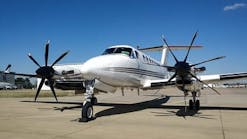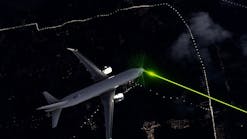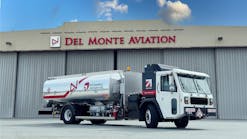To make it a reality: communication, navigation, and surveillance
By Jim Sparks
This free flight version is not to be confused with what you get from the airlines after paying for so many flight segments. In this case free flight is a concept, one that had its seed planted in 1998.
As it stands today the nation’s air traffic follows a well-defined route structure from point to point. Like the nation’s highway system these routes provide limited direct access from city to city. In other words to get from one metropolis to another several highways may have to be utilized. The fact is the air routing structure across the continental United States uses about 5 percent of the total airspace. Wouldn’t it be great to fly from Dallas to New York and not have to turn left at Atlanta? Just imagine the savings in both time and aircraft operating cost.
But on the other hand there are drawbacks. What would happen to air traffic control? With aircraft approaching or leaving any sector in any direction, how are safety margins to be maintained? Sixty years ago when the first radar systems were created for the sole purpose of tracking aircraft to ensure adequate in-flight separation, it was the job of the air traffic controller to project in his mind any potentially lethal situation. With the number of aircraft operating today and expectations for the worldwide fleet doubling by 2010, an already overburdened system would be incapable of controlling the flow. In fact the current system has been related to the telephone company of old where a switchboard operator had to manually plug and unplug each connection.
What do we need?
Communication, navigation, and surveillance (CNS) are the areas that need to be addressed to make free flight a reality along with the concept of air traffic management (ATM) rather than air traffic control (ATC).
Digital electronics is the one primary factor that will provide the means of achieving the goal. Current levels of automation make it realistic for a potential conflict between converging aircraft to be anticipated as much as 20 minutes prior and appropriate actions conveyed to the flight crews to prevent the encounter. Satellite navigation enables the pilot to have pinpoint accuracy in determining aircraft position and with programs like Reduced Vertical Separation Minimums (RVSM) and Required Navigation Performance (RNP), capabilities of the aircraft are enhanced where it can safely operate in a high traffic area in close proximity to other machines.
How far are we from realizing benefits from this concept? In January 2003 the United Parcel Service (UPS) became the first major U.S. air carrier to get U.S. Federal Aviation Administration certification for the installation of Automatic Dependent Surveillance -Broadcast (ADS-B) systems. Although this will not allow unrestricted free flight, UPS is predicting a 20 percent increase in efficiency within a three-year time span as a result.
Aircraft including ADS-B systems have the ability to transmit their specific position along with airspeed, altitude, and attitude information on a digital data link up to 150 miles to either a ground-based receiver linked to the air traffic control network or even to other ADS-B equipped aircraft. Unlike ATC Primary and Secondary Surveillance Radar systems, low altitude and even operation on the ground can be tracked which can aid in assisting the ever prevalent ground congestion at many airports. This will also provide an additional safety margin for aircraft operating in a nonradar environment. Most importantly pilots and air traffic controllers can see the same real-time situations emerging together.
The technology is not in fact limited to aircraft. The possibility exists where airport ground vehicles could be equipped with the system, which could all but eliminate runway incursions or other communications-related ground mishaps. The same data link used here can also transmit weather data, flight information, and flight advisories.
Navigation systems
Any type of navigation system can be used to provide RNP, provided that it meets the required navigation performance accuracy. RNAV equipment
operates by automatically determining the aircraft position using inputs from one, or a combination, of sources such as VOR, DME, Inertial Navigation Systems (INS), and global positioning systems (GPS). The primary means for achieving RNP is by the use of radio navigation equipment.
Currently, a large percentage of commercial as well as private aircraft are outfitted using varying combinations of the above equipment leading to varying degrees of performance and RNP-type approvals. In many cases the aircraft flight manual is the only document needed to prove aircraft compatibility to the local airworthiness authority. The term RNP is most often followed by a number such as “1, 5, or 10”. This implies the statute mile distance for the respective RNP level. Requirements for aircraft operating in RNP-10 airspace include the navigation capability to maintain strict lateral position sensing with an error factor of less than 10 nautical miles 95 percent of the time. Stand alone Inertial Reference Sensors tend to have a certain amount of drift that will make position sensing less accurate as flight time increases.
In European BRNAV/RNP-5 airspace, limitations based on the requirement of ground-based navigation aids may not be an issue for an INS or an Inertial Reference System (IRS) equipped aircraft to gain approval. However that same aircraft would not be approved to operate on the westbound Pacific Organized Track System (PACOTS), which is designated as RNP-10.
Does that mean if you are approved to operate in RNP-4 airspace, you are automatically approved to operate in RNP-10 airspace? An INS-equipped aircraft approved for RNP-4 operation with a time restriction of two hours between navigation systems updates would not be able to operate in the North Pacific Region (NOPAC) designated as RNP-10 without updates. RNP and RNAV operators have the responsibility to ensure that their equipment meets the required “navigation performance accuracy” and that the flight crews will follow prescribed procedures for the respective RNP type environment.
RNP-20 was an early minimum considered acceptable to support various route operations. But it may not be needed any longer as systems currently in use already support minimum separations.
RNP-10 supports reduced lateral and longitudinal separation and enhanced operational efficiency in oceanic and remote areas where the availability of navigation aids is limited. On April 23, 1998 Anchorage Air Route Traffic Control Center (ARTCC) implemented lateral separation standards within the North Pacific route structure from FL 310 to FL 390.
As of Dec. 3, 1998, a 50-nautical mile lateral separation standard was applied in the Central Pacific only to all aircraft that are RNP-10 approved. RNP approval is required from 31,000 feet through 39,000 feet altitude inclusive. A monitoring group was formed to collect, coordinate, and review data to reach an agreement on when to expand 50-nautical mile spacing to additional tracks.
RVSM is another key component to the free flight environment. The International Civil Aviation Organization (ICAO) is making this happen on a worldwide basis. The premise is to space aircraft operating within certain optimum altitudes at 1,000 feet vertical spacing rather than 2,000 feet. This can be achieved once the aircraft is determined to have a static system with minimal error and an auto flight system that can hold the machine at constant flight level with minimal deviation. RVSM is presently scheduled for implementation over the continental United States in late 2004.
What about maintenance?
How do the results of RNP and RVSM affect those of us in the aviation maintenance business? Well for one, a greater awareness has to result.
An example would be to open the nose compartment of the aircraft. This may often be considered an everyday task. What if the aircraft static ports were located just aft of this nose compartment and one day during the closing operation a slight offset occurs in the way the nose fits to the fuselage? The resulting step may have an influence on static port airflow inducing what may be enough static source error to cause the aircraft to become recognized as not being within the prescribed tolerance to allow continued flights in RVSM airspace.
The other issue is the refined use of the aircraft Minimum Equipment List. The operational status of navigation equipment will determine if the aircraft will qualify for flight in RNP or RVSM airspace. One of the requirements for RVSM approval is that the aircraft have two static systems. Many machines utilize two air data computers to interpret the static sensing and provide a correction factor based on airframe design and construction. Where under typical conditions the aircraft could dispatch with one of these air data computers not operating, flight in RVSM airspace would be prohibited.
What will it take to qualify an aircraft for the ultimate free flight? The first thing is a navigation system that has the ability to send digital information, secondly there has to be an onboard communication device such as a specialized transponder that can communicate this data to other aircraft as well as to the ground stations. In addition there has to be a flight deck display where the flight crew can retrieve information about other aircraft or even specific messages from air traffic control. This data display is planned to replace frequent air to ground and ground to air radio messages.
In other words air traffic management would become more automated and the aircraft computers would be communicating directly with the ground-based air traffic computers allowing the flight crews to receive word messages instead of voice communications. One of the main concerns about such a new system is flight crew complacency. This new technology which will be a labor-saving device for flight crews may need to promote an entirely new attitude when it comes to situational awareness. Following an automation failure, time for recovery may be increased and having a high-performance aircraft operating in high-density airspace could have detrimental results.
Everybody from airlines to governments all agree that the free flight concept is a great idea and will reduce air traffic control related delays. With shorter point to point routes, the participants will realize a significant cost savings. And current digital technology will also enable most modern aircraft to include this onboard equipment at a relatively low cost. Unfortunately it has not yet been determined exactly how to begin. This plan will require a complete overhaul of the existing ATC system and require billions of dollars. Where governments and money are concerned, no one could possibly guess the outcome. Nevertheless free flight still has a tone of inevitability.






